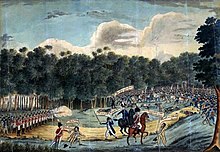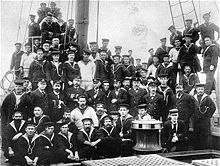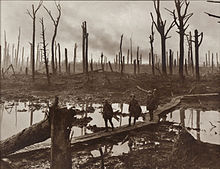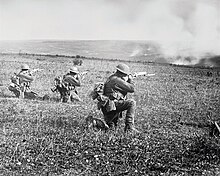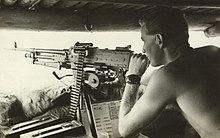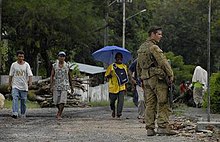Military history of Australia
These ideals include notions of endurance, courage, ingenuity, humour, larrikinism, egalitarianism and mateship; traits which, according to popular thought, defined the behaviour of Australian soldiers fighting at Gallipoli during the First World War.
Regardless, a tendency towards strategic complacency has also been evident, with Australians often reluctant to think about defence issues or to allocate resources until a crisis arises; a trait which has historically resulted in unpreparedness for major military challenges.
Originally Marines protected the early settlements at Sydney Cove and Norfolk Island, however they were relieved of these duties in 1790 by a British Army unit specifically recruited for colonial service, known as the New South Wales Corps.
[44] Following the defeat of the Afrikaner republics still the Boers held out, forming small commando units and conducting a campaign of guerrilla warfare to disrupt British troop movements and lines of supply.
They arrived too late to take part in the battle, but were involved in the attack on the fortress at Pao-ting Fu, where the Chinese government was believed to have found asylum after Peking was captured by western forces.
In 1907 Prime Minister Alfred Deakin and Creswell, while attending the Imperial Conference in London, sought the British Government's agreement to end the subsidy system and develop an Australian navy.
[76] The Australians first saw combat during the Senussi uprising in the Libyan Desert and the Nile Valley, during which the combined British forces successfully put down the primitive pro-Turkish Islamic sect with heavy casualties.
[84] I Anzac Corps subsequently took up positions in a quiet sector south of Armentières on 7 April 1916 and for the next two and a half years the AIF participated in most of the major battles on the Western Front, earning a formidable reputation.
[102] The offensive continued for four months, and during Second Battle of the Somme the Australian Corps fought actions at Lihons, Etinehem, Proyart, Chuignes, and Mont St Quentin, before their final engagement of the war on 5 October 1918 at Montbrehain.
Arriving at Tulagi on 14 October, the ship proceeded to Malaita to protect the landing of three platoons of troops, then remained in the area to provide personnel support for the soldiers as they searched for the killers.
In late 1944, Australian troops and RAAF squadrons replaced US garrisons in eastern New Guinea, New Britain, and Bougainville, and launched offensives aimed at destroying or containing the remaining Japanese forces there.
[147] Following Japan's surrender on 15 August 1945 Australia assumed responsibility for occupying much of Borneo and the eastern Netherlands East Indies until British and Dutch colonial rule was restored.
As a part of the invasion force under the UN Supreme Commander, General Douglas MacArthur, the battalion moved north and was involved in its first major action at Battle of Yongju near Pyongyang on 22 October, before advancing towards the Yalu River.
[171] The belligerents then became locked in static trench warfare akin to the First World War, in which men lived in tunnels, redoubts, and sandbagged forts behind barbed wire defences.
[172] The Australians fought their last battle during 24–26 July 1953, with 2 RAR holding off a concerted Chinese attack along the Samichon River and inflicting significant casualties for the loss of five killed and 24 wounded.
The Dakotas were subsequently used on cargo runs, troop movement, as well as paratroop and leaflet drops, while the Lincoln bombers carried out bombing raids against the Communist Terrorist (CT) jungle bases.
Other projects included the construction of six River-class frigates, the conversion of the aircraft carrier HMAS Melbourne to an anti-submarine role, the acquisition of ten Wessex helicopters, and the purchase of six Oberon-class submarines.
However, by the time the Australian battalion deployed the British had decided on more aggressive action, crossing the border into Kalimantan to obtain information and conduct ambushes to force the Indonesians to remain on the defensive, under the codename Operation Claret.
[182] A squadron of the Special Air Service Regiment (SASR) was also deployed in 1965 and again in 1966, taking part in cross-border operations and inflicting significant casualties on the Indonesians, even though they were often tasked with covert reconnaissance.
Australia also committed ground forces, dispatching the 1 RAR to serve with the US 173rd Airborne Brigade in Bien Hoa province in June 1965 and it subsequently fought a number of significant actions, including Gang Toi, Operation Crimp and Suoi Bong Trang.
Consisting of two infantry battalions as well as armour, aviation, artillery and other support arms, the task force was assigned primary responsibility for its own area and was based at Nui Dat, in Phuoc Tuy Province.
[190] 1 ATF was subsequently deployed astride infiltration routes leading to Saigon to interdict communist movement against the capital as part of Operation Coburg during the 1968 Tet Offensive and later during the Battle of Coral–Balmoral in May and June 1968.
At Fire Support Bases Coral and Balmoral the Australians had clashed with regular North Vietnamese Army and Viet Cong main force units operating in battalion and regimental strength for the first time in near conventional warfare, ultimately fighting their largest, most hazardous and most sustained battle of the war.
[192] Although the importance of 'joint' warfare had been highlighted during Second World War when Australian naval, ground and air units frequently served as part of single commands, the absence of a central authority continued to result in poor co-ordination between the services in the post-war era, with each organising and operating on the basis of a different military doctrine.
[209][210][211] Australia was a member of the international coalition which contributed military forces to the 1991 Gulf War, deploying a naval task group of two warships, a support ship and a clearance diving team; in total about 750 personnel.
The United Nations Mission in East Timor (UNAMET) was established to organise and conduct the vote, which was held at the end of August 1999 and resulted with 78.5% of voters deciding in favour of independence.
However, following the announcement of the results pro-Indonesian militias supported by elements of the Indonesian military, launched a campaign of violence, looting and arson and many East Timorese were killed, while perhaps more than 500,000 were displaced.
[219] Under the overall command of Australian Major General Peter Cosgrove, INTERFET began arriving on 12 September 1999 and was tasked with restoring peace and security, protecting and supporting UNAMET, and facilitating humanitarian assistance operations.
[235] In November 2020, a report for the Inspector-General of the Australian Defence Force by Major General Paul Brereton, a New South Wales Court of Appeal judge, found credible information that 25 current or former members of the ADF were involved in, or accessories to, the murder of 39 Afghan prisoners and civilians, and the cruel treatment of two others.
[246] Later, in August and September a number of RAAF C-17 and C-130J transport aircraft based in the Middle East were used to conduct airdrops of humanitarian aid to trapped civilians and to airlift arms and munitions to forces in Kurdish-controlled northern Iraq.

